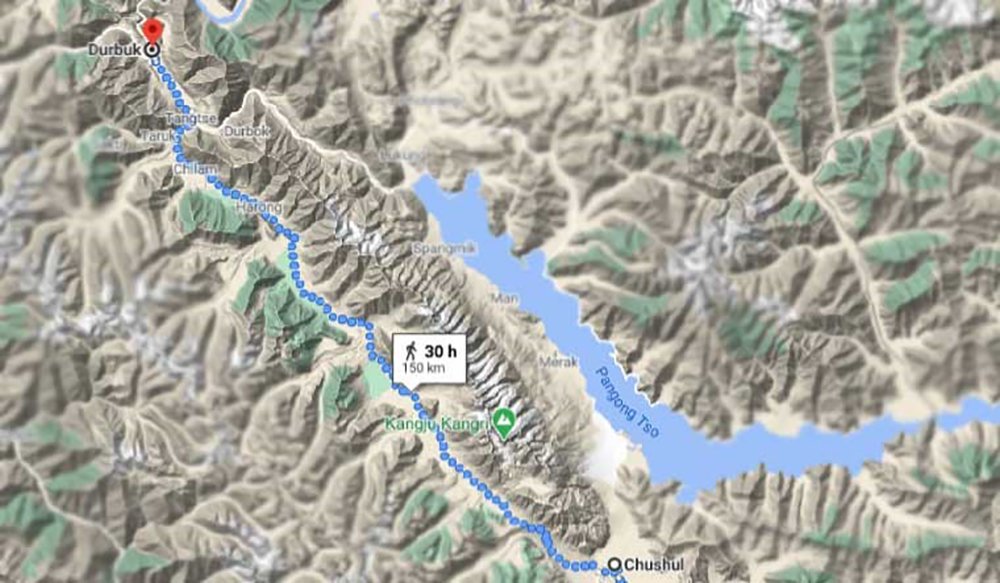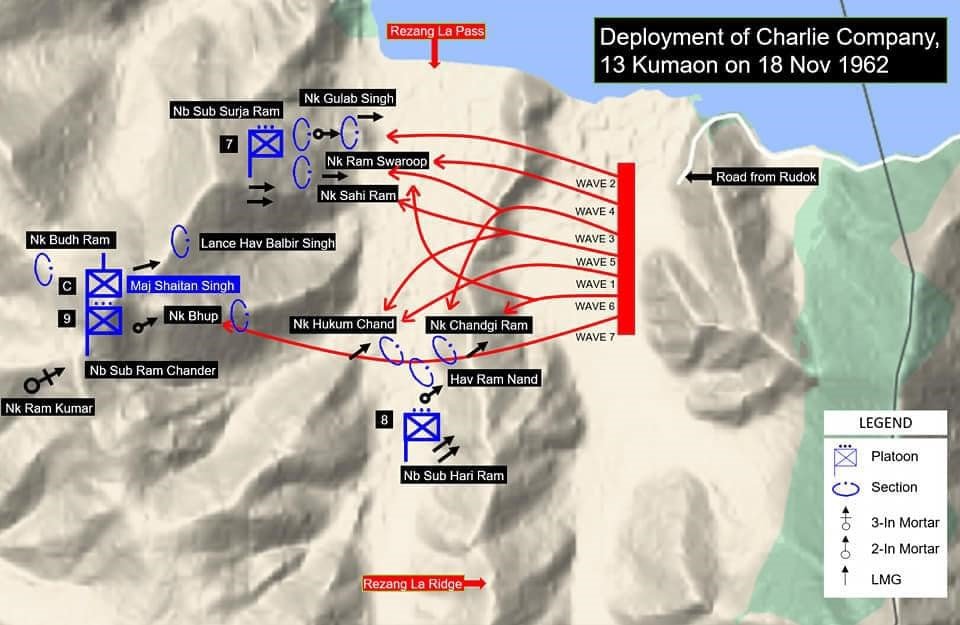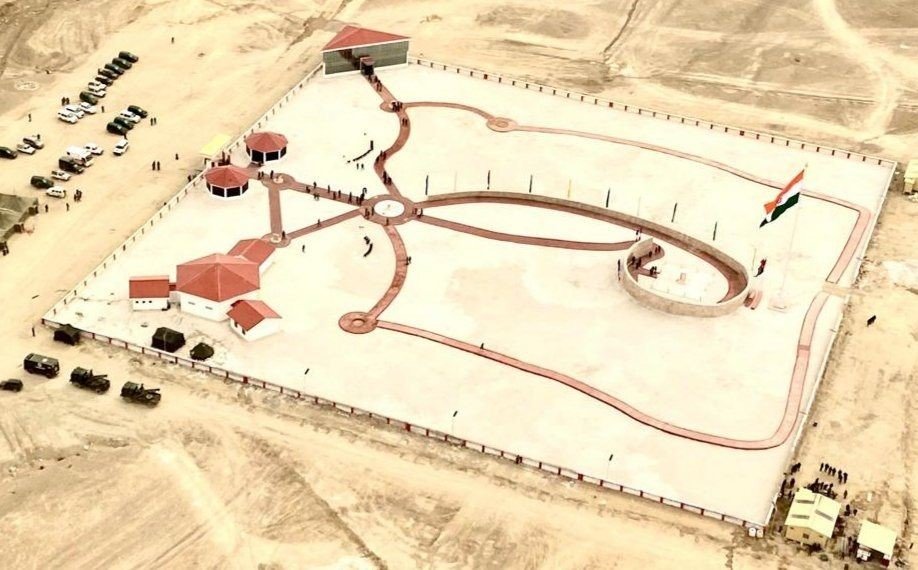The Battle of Rezang La, fought on November 18, 1962 in the Chushul sector of Ladakh, remains one of the most studied small-unit actions in India’s military history. C Company, 13 Kumaon—approximately 120 soldiers under Major Shaitan Singh—held an exposed high-altitude position against a far larger and better-supported Chinese assault. Although the post was eventually overrun, the stand is remembered for exceptional leadership, discipline, and sacrifice. The battle offers insights into the challenges of mountain warfare, the limits of static defences, and the importance of cohesive small-unit leadership—lessons relevant even in today’s high-altitude standoffs.
Rezang La lies at roughly 16,000–17,000 feet, guarding the eastern shoulder of the Chushul Valley and the Chushul airstrip—India’s only viable conduit for rapid reinforcement in 1962. The Sino-Indian War’s western sector was marked by tenuous logistics lines into Ladakh, limited road connectivity, severe weather constraints, and Indian forward posts dispersed across difficult terrain.
The Chinese Western Theatre Command sought to capture dominating features overlooking Chushul to force a collapse of Indian defensive depth. Rezang La’s geographical importance stemmed from its control over approach routes from the Spanggur Gap. Holding this ridge was essential for delaying any deep Chinese push into Chushul.

Disposition of Forces
C Company’s deployment consisted of well-camouflaged platoon posts arranged in a broad arc along the ridge, with clear fields of fire onto likely enemy approaches. However, these advantages came with structural vulnerabilities:
- No lateral road connectivity for rapid reinforcement or withdrawal.
- Limited artillery support due to rarefied air and line-of-sight issues.
- Thin communications, reliant on wireless sets that were quickly neutralised.
- Extreme temperatures, reducing weapon effectiveness and soldier endurance.
The unit was composed largely of Ahir troops from the Ahirwal belt, known for cohesion and familiarity with infantry tradition—factors that later shaped regimental accounts of the battle.
The Battle of Rezang La (1962) offers insights into the challenges of mountain warfare, the limits of static defences, and the importance of cohesive small-unit leadership. These lessons remain relevant even in today’s high-altitude standoffs
The Assault: Sequence and Character
At dawn on November 18, Chinese forces initiated a multi-wave assault combining heavy mortar and artillery bombardment, infantry assaults in successive echelons, and flanking attempts through dead ground not easily visible from Indian positions.
Although popularly described as “human-wave attacks,” Chinese doctrinal literature frames these actions as regimental-strength assaults with concentrated preparatory fire. Regardless of terminology, the defenders were outnumbered, isolated, and operating without real-time intelligence on enemy strength.

Indian platoons followed disciplined fire control, allowing enemy troops to close to effective rifle and light machine gun (LMG) range before opening fire. Initial waves were repulsed with devastating effect. However, ammunition stocks began depleting, casualties mounted among machine-gunners and non-commissioned officers (NCOs), and Chinese infiltrators exploited blind approaches, encircling outer posts.
By midday, communication lines were severed. The entire company was fighting in isolated pockets.
Leadership and Morale
Major Shaitan Singh’s leadership was decisive. Despite exposure to fire and the thinning oxygen environment, he moved between platoon positions to reorganise defences, personally coordinating ammunition redistribution, motivating exhausted soldiers, and ensuring no post abandoned its sector.
When severely wounded, he insisted his men leave him behind to prevent slowing withdrawal. His actions earned the Param Vir Chakra posthumously and became emblematic of battlefield leadership under extreme adversity.
Subalterns and NCOs demonstrated similar resolve—relocating LMGs to secondary fire positions, improvising during weapon malfunctions, and coordinating defence through shouted commands when wireless sets failed. This combination of top-down and bottom-up leadership explains the unusually cohesive resistance despite overwhelming odds.
Casualties and Conflicting Numbers
The outcome was devastating for C Company, as 114 of approximately 120 soldiers were killed in action. Only a handful survived, several as prisoners or wounded stragglers (soldiers who got separated from their unit during combat or retreat). Chinese casualty figures remain debated.
Indian accounts suggest heavy losses, often citing figures in the hundreds, while Chinese sources acknowledge casualties but far fewer. Academic consensus holds that Chinese forces suffered significant attrition in the early waves, but exact figures remain unverifiable without bilateral archival access.
Indian platoons followed disciplined fire control, allowing enemy troops to close to effective rifle and LMG range before opening fire. Initial waves were repulsed with devastating effect
The divergence illustrates the broader challenge of casualty assessment in high-altitude combat, where retrieval, burial, and documentation are limited.
Tactical and Operational Lessons
Vulnerability of Static Defence in High-Altitude Terrain. Rezang La demonstrated the risk of defending isolated posts without mutually supporting fire plans. Modern doctrine now emphasises interlocking fire systems, flexible sector reserves, and greater air–ground integration.
Importance of Multi-Layered Logistics. The thin supply chain into Chushul severely limited India’s ability to reinforce or resupply C Company. Present-day Ladakh deployments feature all-weather roads, pre-winter stocking, advanced gun systems, and dedicated air-maintenance schedules. These improvements draw directly from post-1962 re-evaluations.
Leadership as a Combat Multiplier. Rezang La is routinely studied at the Indian Military Academy and Defence Services Staff College as a case where small-unit leadership compensated for severe tactical disadvantages. The battle demonstrates the impact of commander presence, cohesion built through regimental culture, and the resilience produced by a clear, shared purpose.
Communication Redundancy. When wireless sets were destroyed early in the assault, C Company effectively fought blind. Contemporary high-altitude communications—satcom, HF redundancy, encrypted tactical radios—seek to avoid similar collapses.
Intelligence and Surveillance. Rezang La suffered from minimal real-time intelligence on enemy movement. Today, UAVs, counter-drone sensors, and satellite surveillance provide situational awareness that was unimaginable in 1962.
Major Shaitan Singh’s leadership was decisive, as he moved between platoon positions to reorganise defences and motivate exhausted soldiers. His actions became emblematic of battlefield leadership under extreme adversity
Memory, Commemoration, and Interpretation
The Rezang La Memorial, built in 1963 and renovated recently, stands as a tribute to the “Ahir Company” that defended the ridge. Public and regimental commemorations—particularly in Rewari, Haryana—have cemented Rezang La in India’s strategic and cultural memory.

Recent cinematic depictions and media narratives have brought renewed attention to the battle, though sometimes with dramatisation. Academic treatment seeks to balance honouring the soldiers’ courage, avoiding romanticisation, and analysing operational shortcomings objectively. This balanced approach ensures the battle’s lessons remain relevant rather than symbolic alone.
Relevance to Contemporary Ladakh Dynamics
The India–China standoff since 2020 has revived strategic attention to the Chushul sector. Rezang La’s historical lessons resonate strongly in the current context:
- Terrain dominance remains crucial to preventing deep ingress.
- Integrated air–ground logistics are essential for sustaining troops at altitude.
- Rapid build-up capability has reshaped India’s posture compared to 1962.
- Deterrence through presence reduces the likelihood of isolated positions being overrun.
Takeaways
Rezang La provides an enduring baseline for assessing how far India’s mountain warfare capabilities have evolved. The Battle of Rezang La stands at the intersection of military history, strategic geography, and national memory. It was a small-unit action fought under extreme disadvantage, yet marked by unmatched discipline and leadership. Although it did not change the outcome of the 1962 war, it changed the trajectory of India’s military thinking thereafter.
The India–China standoff since 2020 has revived strategic attention to the Chushul sector. Rezang La’s historical lessons resonate strongly in the current context
For defence practitioners, Rezang La is more than a heroic tale—it is a case study in the realities of high-altitude warfare: the necessity of logistics, the limits of static defence, and the decisive power of cohesive units led by resolute commanders.
References
- D.K. Palit, War in High Himalaya: The Indian Army in Crisis, 1962.
- Neville Maxwell, India’s China War.
- Official History Division, Ministry of Defence, History of the Conflict with China, 1962.
- Bharat Rakshak Archives: “13 Kumaon at Rezang La.”
- Oral testimonies compiled in Sainik Samachar and regimental publications.
-The author retired as Major General, Army Ordnance Corps, Central Command, after 37 years of service. A management doctorate and expert on defence modernisation, he is the author of four books, including the Amazon bestseller “Breaking the Chinese Myth,” and a frequent media commentator. He is affiliated with several leading defence and strategic studies institutions in New Delhi. The views expressed are of the writer and do not necessarily reflect the views of Raksha Anirveda






